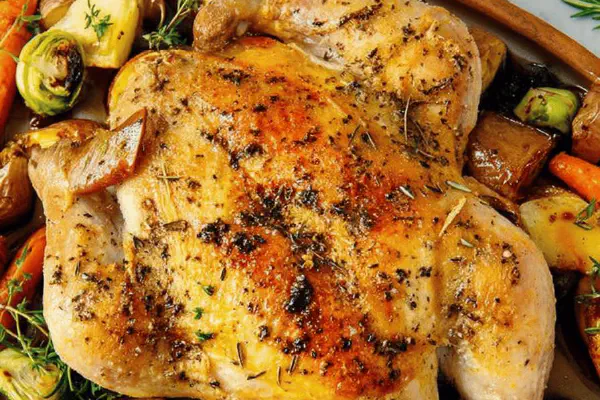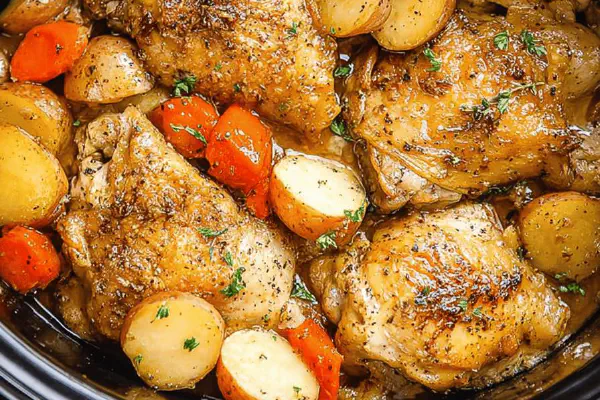Herbed Spatchcock Chicken

By Emma
Certified Culinary Professional
Ingredients
- 3-4 pound whole chicken
- 6 tablespoons extra virgin olive oil
- 4 sprigs fresh thyme leaves
- 3 sprigs fresh sage leaves instead of rosemary
- 5-6 cloves garlic finely minced or pressed
- 1/4 pound purple potatoes quartered
- 1/4 pound fingerling potatoes quartered
- 1/4 pound Brussels sprouts halved
- 4 medium carrots halved lengthwise then quartered crosswise
- Kosher salt
- Fresh ground black pepper
- Optional whole herb sprigs (thyme or sage) for roasting pan
About the ingredients
Method
Spatchcock the Chicken
- Start by removing any giblets and trimming excess skin especially around the neck. Look for loose flaps that will burn if left on. Pat dry thoroughly with paper towels; moisture kills crisp skin. Lay chicken breast side down, legs facing you on a stable cutting board.
- Use your finger to trace along the backbone; feel that hard ridge between softer ribs. Identify the spine for cutting.
- Grab chicken shears. Begin snipping at the tail end on the right side of the backbone in firm, long cuts through bone. The bones are thin but dense; brace yourself, slow and deliberate. Repeat on the left side.
- If you don’t have shears, place a sharp chef’s knife just beside the spine and cut down with one forceful motion using the heel of your palm to push through the ribs. Go slowly at first to avoid slipping. Remove the backbone completely—it’s a bit of a wrestling match. Discard or save for stock.
- Flip the bird so breast side up, cavity down. This next move releases tension. Press hard with the heel of your hand on the breastbone until you hear a slight crack; the bird should flatten out fully. Don’t be timid here; this step ensures even cooking.
Roast the Chicken and Veggies
- Preheat oven to 480°F for that initial blast of heat—this gets skin crackling fast. While warming, mix 6 tablespoons olive oil, fresh thyme leaves, sage leaves, and the garlic. Stir well; the raw garlic punches the oil with aroma.
- Drizzle about 2 tablespoons of this mixture over the chicken both sides, rub it in with clean hands. Reserve the rest for the vegetables. Salt the bird generously—Kosher salt is forgiving yet effective—and dot with black pepper. This seasoning method makes the flavors punch through the skin.
- Prep veggies while chicken starts warming. Cut carrots lengthwise in half, then crosswise into quarters. Same size for fingerling and purple potatoes helps everything cook evenly. Toss veggies in remaining herb-garlic oil in a bowl using a wooden spoon or silicone spatula gently—don’t bruise too hard.
- Spread the veggies around the chicken on the rimmed baking sheet. Scatter any leftover garlic cloves over veggies. Salt and season the vegetables sparingly; herbs on top add aroma but skip if you want a crispier roast surface.
- Put pan in oven. Roast for 15 minutes at 480°F. You’ll hear sizzling and start to see skin browning at edges; this is critical. Lower oven to 395°F and continue roasting for 35-40 minutes. Start looking for juices running clear when you poke near the thigh and an internal temp near 160°F. Don’t rely only on time—sensorial checks win here.
- Every 10 minutes, check veggies. Gently turn with tongs or spatula to avoid tearing. They should develop some golden edges but not fall apart into mush.
- Once chicken is done, rest it tented loosely with foil for 10 minutes. This step seals juices back into meat or risk drying. Vegetables will continue to soften slightly under the chicken’s warmth during resting.
- If no fresh rosemary on hand, sage is a great substitute—earthier, less piney. Garlic powder can replace fresh cloves, but fresh garlic caramelizes better and lends a sweeter note. If you lack shears, use a sharp, sturdy knife carefully. Watch your fingers.
- The cracking noise when flattening the chicken? Essential. If it won’t crack, your bird is cold or very tough; warm slightly or press harder. Keep the skin dry—any wetness makes for steamed, soggy skin instead of that crisp snap.
- Serve right from the pan. The roasted herbs smell outlandish. Carrots should yield tender bite, potatoes fluffy inside with faint crust. Chicken skin crisp, meat juicy, herbs in every tender bite.
- Cleanup tip: soak the pan immediately to prevent stuck roasted bits from becoming a nightmare to scrub. Done correctly, the roasting pan will have treasure trove drippings perfect for gravy or sauce.
- In case the skin is stubbornly soft after roasting, pop under broiler for 2-3 minutes but watch like a hawk. Caramelization should be a deep golden brown, not blackened.
- Chicken spatchcocking speeds cooking, helps even browning, and easy to carve once rested. Plus, roasting veggies at the same time means fewer dishes and better mingled flavors. All in one shot. Fancy dinner? Nailed.
Cooking tips
Chef's notes
- 💡 Bone crack sound means flattened bird. No crack? Bird cold or thick breast. Warm slightly; press firm on breastbone until distinct snap. Don’t hesitate. Flat chicken cooks evenly, skin crisps up evenly. Pat skin dry like mad. Moisture steals crispness fast. Keep towels handy; press under flap areas too.
- 💡 High heat blast of 480F starts skin blistering immediately. Don’t skip this stage. Fifteen minutes enough to brown edges then drop temp to 395F. Constant skin check—browning edges first hint. Juices clear near thigh signals almost done but internal temp near 160F has final say, never eyeball alone.
- 💡 Veggie uniformity matters. Carrots split lengthwise then quartered across. Potatoes cut similar size, quartered. Smaller means mush faster. Bigger means crunchy roots lagging. Toss gently in reserved herb-garlic oil. Avoid bruising or smashing flesh. Herbs give aroma but salt veggies lightly or skin won’t crisp well.
- 💡 No fresh rosemary? Sage’s earthiness works better with roasted garlic’s sweet smell here. Garlic powder can back up fresh cloves. But fresh garlic caramelizes giving sweeter, deeper aroma. Use entire sprigs in roasting pan for subtle aroma release. Toss leftover smashed garlic with veggies for surprise bursts.
- 💡 Knife instead of shears? Perfectly doable. Careful deep cuts beside spine with chef’s knife heel pressure. Slow but steady. No slipping or rushing. Keep finger positioning safe. Backbone removal crucial for flat lay; can scrap for stock later. Don’t skip trimming loose skin around neck and flaps. Those burn sharp quickly.
Common questions
How to know when chicken is done?
Skin crackling golden first sign. Juices clear when poked near thigh—not pink. Temp near 160F thickest part. Don’t rely only on time. Feel meat firmness too. Juicy but not soft. Wait with rest before carving.
Can I use rosemary instead of sage?
Definitely yes. Sage more earthy, savory with garlic though. Rosemary sharper piney flavor. Use whatever herb suits your taste. Leaves whole or chopped fine, both work. Sprinkle with herbs on vegetables or just under skin too.
What if skin won’t crisp?
Often skin damp or bird cold. Dry skin thoroughly. Pat skin before oil. Oven temp too low might steam rather than roast; blast 480F first. Press on breast so chicken lies flat—uneven cooking messes skin texture. Last resort broiler for few minutes but watch closely.
How to store leftovers?
Cool completely before refrigerating loosely covered. Use airtight container if possible, but don’t trap moisture. Reheat in oven to crisp skin again or stir-fry shredded meat into other dishes. Freeze bones with some meat for stock. Veggies lose crispness but still tasty cold or reheated.



